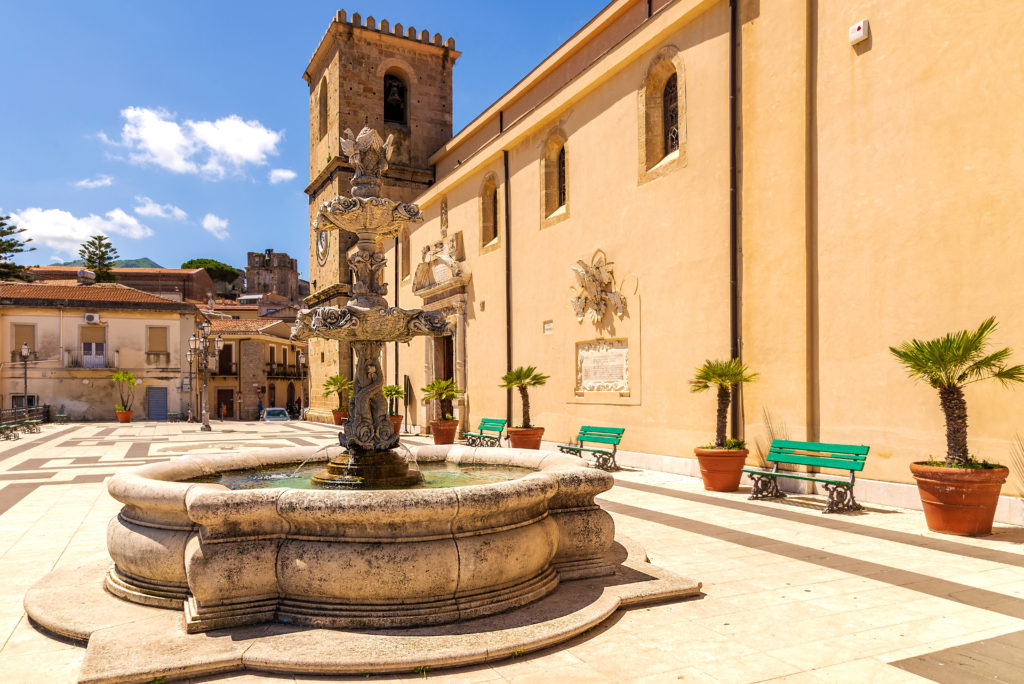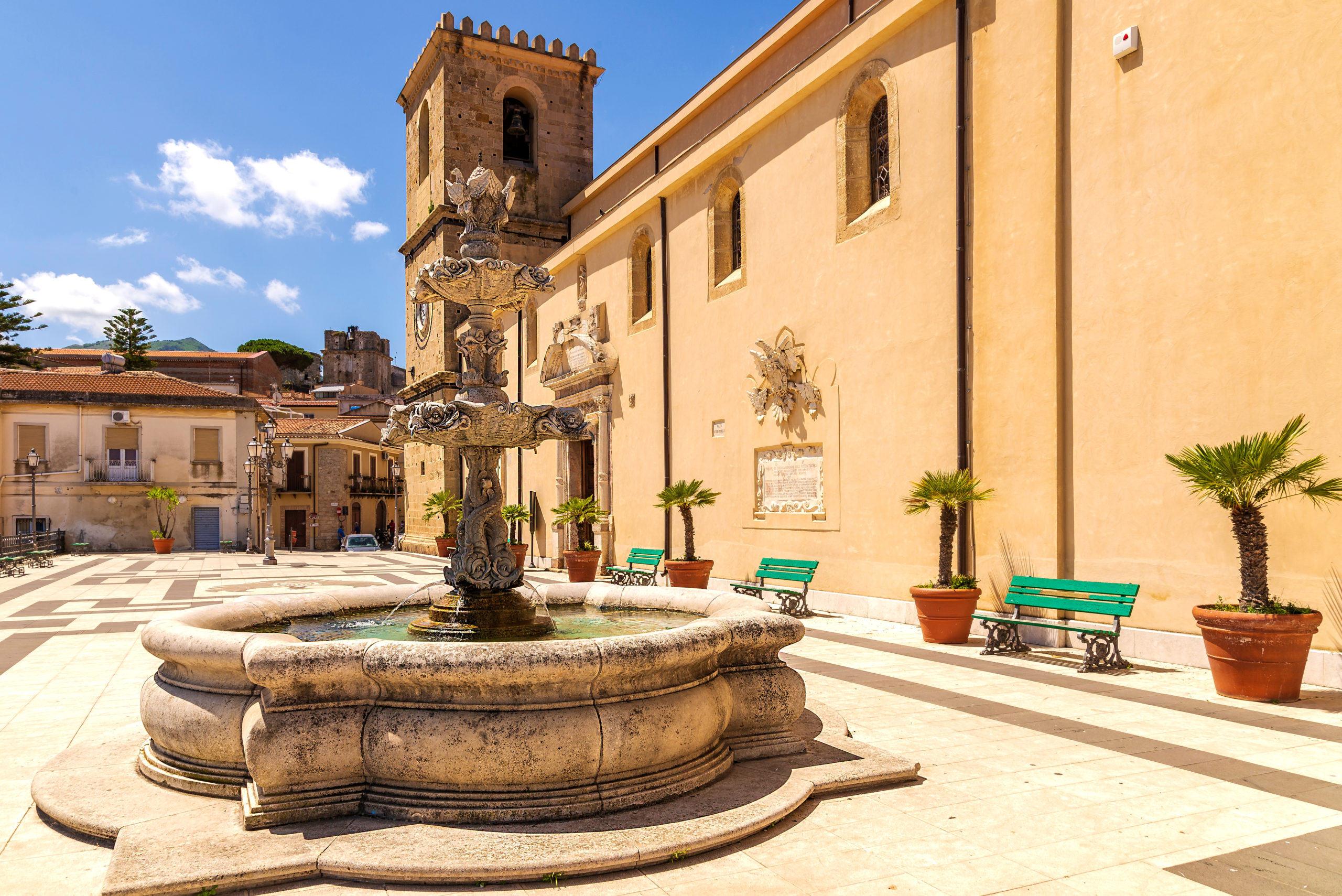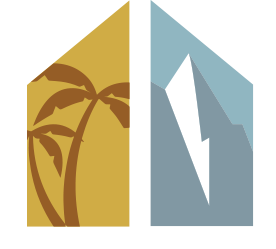
Castroreale is a picturesque village located in the province of Messina, is one of Sicily’s hidden gems. Known for its rich historical and artistic heritage, this town offers a journey back in time, through narrow, steep streets paved in stone, known as “jacatu” as it is called in the local dialect, Baroque churches, noble palaces and stunning panoramic views. Perched on a hilltop between the Tyrrhenian Sea and the Nebrodi Mountains, it offers breathtaking views of the surrounding landscape, including the Aeolian Islands, rich history, and a deep connection to Sicily’s traditions and culture. The village is home to numerous churches, works of art, and historical buildings, including the remains of a castle built by Frederick II of Aragon in 1324. Whether you’re visiting for the historical sites, local cuisine, or natural beauty, Castroreale is a hidden gem for those seeking an authentic Sicilian experience away from the crowds.
Castroreale is also recognized as one of “The most beautiful villages of Italy” (ranked Italy’s 2nd most beautiful Village in 2018). It’s a charming destination for those interested in history, art, and breathtaking scenery. Have you had the chance to visit Castroreale, or is it on your travel bucket list?
A Bit of History
The origins of the village date back to the Middle Ages, and the town is known for its medieval charm. The name Castroreale derives from the Latin words “castrum” (fortress) and “reale” (royal), reflecting its strategic location as a fortified settlement.
- Norman and Medieval History: The town has been influenced by several ruling powers over the centuries, beginning with the Normans in the 11th century, who built the first fortifications. These were later expanded by the Swabians and Aragonese during the medieval period, which are reflected in the local architecture and traditions. It gained importance during the reign of Frederick II of Aragon, who ordered the construction of a castle in 1324 to reward the village for its loyalty during the War of the Vespers.
- Feudal Era: During the feudal era, Castroreale was part of the landholdings of local noble families. It retained its importance as a defensive stronghold until the late Middle Ages.
- Jewish Community: until the end of the 15th century, Castroreale had a large and active Jewish community. The synagogue, enlarged in 1487, still has remnants visible today.
- Baroque Influence: In the 17th and 18th centuries, the town experienced Baroque architectural influences, seen particularly in its churches and public buildings, adding to the village’s architectural charm.
Attractions
Museums
- The Duomo di Castroreale, also known as the Mother Church of Santa Maria Assunta, is the largest church in Castroreale. It is located in the main square, Piazza delle Aquile. The church’s construction began in the 15th century, and it has undergone several renovations and expansions over the centuries. The façade features a mix of Mannerist and Baroque architectural styles, with a majestic marble portal at its center. Inside, the church features a Latin cross form with three naves and several notable works of art, including statues by Antonello Gagini and a meridian line that runs across the floor of the central nave, indicating the South-North direction of the terrestrial meridian. The church also contains the richly carved choir and the 17th century organ, the XVI century polyptych of the nativity of Christ of Giovanni Criscuolo.
- Church of the Candelora: dating back to the 14th century, it was likely built as the chapel for the Castle of Frederick II of Aragon. The church features a distinctive brick façade with a portal in the “Durazzesco” style, a 17th-century wooden altar, and a hemispherical dome influenced by Arabic architecture. Inside, you can find a grand wooden tribune from the 1600s, richly carved and gilded, housing a statue of the Madonna and six painted panels depicting scenes from the Virgin’s life.
- Church of Sant’Agata: built in 15th century, rebuilt in the 19th century. Rich in works of art, including the marble group of the “Annunciation” by Antonello Gagini, a statue of “Sant’Agata” by Montorsoli and the statue of “Cristo Lungo” (long Christ), a relic of great devotion.
- Castle Tower: this medieval tower, also known as the “Torre di Federico II,” dates back to the 13th century and was part of a larger castle complex built by Frederick II of Aragon. The tower offers stunning views of the surrounding landscape, including the Tyrrhenian Sea and the Aeolian Islands.
- Church of Santa Maria degli Angeli: originally built in the 15th century, this church is no longer used for worship but now houses a collection of artworks from the 15th and 16th centuries. Notable pieces include a triptych by the Flemish School, a marble statue of the Virgin by Antonello Freri, and various other religious artworks.
- Church of SS. Salvatore: dating back to the 15th century. It has a rich history and has undergone several changes over the centuries. The church was damaged by an earthquake, and its bell tower Campanaria, which dates from the second half of the 16th century, is partially collapsed.
- Church of Santa Marina: dating back to the 13th century. It incorporates some structures from Norman times, reflecting the rich architectural heritage of the region. The church is known for its historical significance and its role in the religious and cultural life of Castroreale.
- Church of San Filippo Neri: it’s a significant historical and cultural site. This church is part of the Oratory of St. Philip Neri, which also houses the Civic Museum.
- Church of Immacolata: dating back to the 15th century. Originally built in 1498, it was renamed in 1643. The church features a coffered ceiling from 1690, an apse with a hemispherical dome, and a blind lantern. Unfortunately, it was damaged by an earthquake in 1978 and has been closed to the public due to partial roof collapses. Inside, it houses a non-functional pipe organ and an ancient altar.
- Palazzo Peculio: It was built in the 16th century and today houses the municipal offices. The palace is an example of Renaissance architecture and features a stone facade with a central portal and two lateral windows.
- Porta Raineri: a medieval gate that once protected the town. It was built in the 16th century and takes its name from Raineri di Montalto, who was the lord of Castroreale at the time. The gate is in Renaissance style and has a round arch.
- Civic Museum: located in the Oratory of St. Philip Neri, it houses a collection of sculptures in wood and marble, including the tomb of Geronimo Rosso by Antonello Gagini, and a series of remarkable paintings.
- Small Motorcycle Museum: this small but fascinating museum is a must-visit for motorcycle enthusiasts. It showcases a collection of vintage motorcycles and memorabilia, offering a glimpse into the history and evolution of motorbikes. It’s a popular attraction in Castroreale, providing visitors with an opportunity to admire beautifully restored bikes and learn about their significance.
- Jalari Park Museum: an open-air museum that houses archaeological finds and a rich collection of artifacts.
Events and traditions
- Cristo Lungo Festival: one of the most heartfelt and spectacular events in Sicily, a unique blend of faith, tradition, and art. Celebrated annually on August 23-25, it commemorates a miraculous event from 1854 when the village was spared from a cholera epidemic. The festival features a procession where a life-sized crucifix, mounted on a 13-meter-high pole, is carried through the streets. This unique procession is a major attraction, drawing visitors from all over to witness the event and participate in the celebrations.
- Castrician Biscuit Festival: a local culinary event celebrating the traditional Castrician Biscuit. Visitors will enjoy the delicious combination of the local biscuit with refreshing lemon granita. (August)
- Castroreale Jazz Festival: this festival has been a staple in the jazz music scene for over twenty years, attracting big names from the international jazz community. The event typically takes place in the historic center of Castroreale, providing an evocative setting for the performances. The festival features a mix of national and international artists, offering a diverse range of jazz music. (July/August)
- Corpus Christi Flower Festival: during this festival, the streets of Castroreale are adorned with intricate floral carpets and decorations, creating a stunning visual display. The festival includes a procession where the Blessed Sacrament is carried through the streets, accompanied by music and prayers. (June)
Traditional Dishes
- Pesce Stocco a Ghiotta: A traditional dish made with stockfish, tomatoes, olives, capers, and onions.
- Maccheroni al Ragù: Homemade pasta served with a rich meat sauce.
- Pane Cunzato: A seasoned bread topped with tomatoes, cheese, anchovies, and olive oil.
- Black Rice: This is a traditional Sicilian dessert made with rice, almonds, sugar, chocolate, and spices. It is often served during the Christmas season.
- Abbess’s biscuits: These biscuits are a specialty of Castroreale and are made with aniseed, cinnamon, lard, sugar, cloves, vanilla, brewer’s yeast, homemade sourdough, flour, water, and salt. The recipe was invented by the Poor Clare nuns of the Monastery of S. Maria degli Angeli in Castroreale and was kept secret for a long time.
- Other Sicilian dishes: You can also find other typical Sicilian dishes in Castroreale, such as granita, pasta alla norma, cannoli, Sicilian cassata, and arancini.
Naturalistic Events
- Excursions: the area around Castroreale offers numerous paths for hiking or mountain biking, to discover breathtaking landscapes.
- Planetarium: this astronomical simulator projects a faithful image of the sky and its inhabitants and offers visitors the opportunity to observe and recognize the major constellations.


